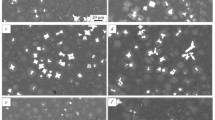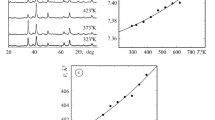Abstract
The conditions of the formation of stable and metastable aluminides Aln(Zr1 – xNbx) formed during the crystallization of superheated melts of the Al‒Zr‒Nb system are considered. Upon a close zirconium content in the alloys of 0.23–0.25 at %, the niobium content varies from 0.05 to 0.21 at %. Alloys are prepared in a resistance furnace at a temperature of 1230°C in an argon atmosphere in graphite crucibles. The alloys are cast into a bronze mold; the cooling rate is estimated as 200°C/s. The structural features, distribution, and morphology; the composition of matrix, dendritic cells, and aluminides; and the structural type of aluminides in the alloys are studied using scanning electron and optical microscopy, X-ray diffraction, and inductively coupled plasma atomic emission spectroscopy. It is shown that the growth forms of stable aluminides (D023 structural type) change from faceted to dendritic and primary metastable aluminides (L12 structural type) begin to form; in the process of the Al‒Zr‒Nb melt, overheating was 360–365°C above the liquidus temperature. Exclusively metastable aluminides with both polyhedral and dendritic growth forms are formed in the Al‒Zr‒Nb alloys when the overheating of their melt is 390–395°C (as well as at higher overheating) above the liquidus temperature. The near-peritectic niobium composition of the Al‒Zr‒Nb alloy and the zirconium content (more than seven times higher than peritectic) are crucial factors in the formation of a large fraction of metastable AlnZr aluminides having a cubic L12 structure. It is shown that, in accordance with the rules of isomorphism, Nb replaces Zr at equivalent positions of the aluminides crystal lattice. The intensity of isomorphism of the formed Al4(Zr0.79Nb0.21) aluminides increases with the increase in temperature of the melt overheating.




Similar content being viewed by others
Notes
Here and below, at % is assumed unless otherwise specified.
REFERENCES
Zakharov, V.V., About alloying of aluminum alloys with transition metals, Met. Sci. Heat Treat., 2017, vol. 59, nos. 1–2, pp. 67–71. https://doi.org/10.1007/s11041-017-0104-2
Pozdnyakov, A.V., Osipenkova, A.A., Popov, D.A., Makhov, S.V., and Napalkov, V.I., Effect of low additions of Y, Sm, Gd, Hf and Er on the structure and hardness of alloy Al–0.2% Zr–0.1% Sc, Met. Sci. Heat Treat., 2017, vol. 58. nos. 9–10, pp. 537–542. https://doi.org/10.1007/s11041-017-0050-z
Wu, H., Wen, S.P., Gao, K.Y., Huang, H., Wang, W., and Nie, Z.R., Effect of Er additions on the precipitation strengthening of Al-Hf alloys, Scr. Mater., 2014, vol. 87, pp. 5–8. https://doi.org/10.1016/j.scriptamat.2014.06.005
Stan, K., Litynska-Dobrzynska, L., Ochin, P., Garzel, G., Wierzbicka-Miernik, A., and Wojewoda-Budka, J., Effect of Ti, Zr and Hf addition on microstructure and properties of rapidly solidified Al–Mn–Fe alloy, J. Alloys Compd., 2014, vol. 615, pp. S607–S611. https://doi.org/10.1016/j.jallcom.2013.11.160
Tkacheva, O.Yu., Brodova, I.G., Arkhipov, P.A., and Zaikov, Yu.P., Effect of crystallization conditions on structure and modifying ability of Al–Sc alloys, Russ. J. Non-Ferrous Met., 2017, vol. 58, no. 7, pp. 67–74. https://doi.org/10.3103/S1067821217010126
Yu, P., Yana, M., Tomus, D., Brice, C.A., Bettles, C.J., Muddle, B., and Qian, M., Microstructural development of electron beam processed Al–3Ti–1Sc alloy under different electron beam scanning speeds, Mater. Charact., 2018, vol. 143, pp. 43–49. https://doi.org/10.1016/j.matchar.2017.09.005
Popova, E.A., Shubin, A.B., Kotenkov, P.V., Pastukhov, E.A., Bodrova, L.E., and Fedorova, O.M., Al–Ti–Zr master alloys: structure formation, Russ. Metall. (Engl. Transl.), 2012, no. 5, pp. 357–361. https://doi.org/10.1134/S0036029512050126
Popova, E.A., Kotenkov, P.V., Shubin, A.B., and Pastukhov, E.A., Peculiarities of the Al–Hf–Sc master alloys structure, Russ. J. Non-Ferrous Met., 2017, vol. 58, no. 6, pp. 639–643. https://doi.org/10.3103/S1067821217060086
Popova, E., Kotenkov, P., Shubin, A., and Gilev, I., Formation of metastable aluminides in Al–Sc–Ti (Zr, Hf) cast alloys, Met. Mater. Int., 2019. https://doi.org/10.1007/s12540-019-00397-x
Popova, E.A., Kotenkov, P.V., and Shubin, A.B., Metastable aluminides formation in Al–Hf–Ti alloys, Tsvetn. Met. (Moscow, Russ. Fed.), 2017, no. 11, pp. 65–70. https://doi.org/10.17580/tsm.2017.11.12
Srinivasan, S., Desch, P.B., and Schwarz, R.B., Metastable phases in the Al3X (X = Ti, Zr, and Hf) intermetallic system, Scr. Metall. Mater., 1991, vol. 25, no. 11, pp. 2513–2516. https://doi.org/10.1016/0956-716X(91)90059-A
Malek, P., Janecek, M., Smola, B., Bartuska, P., and Plestil, J., Structure and properties of rapidly solidified Al–Zr–Ti alloys, J. Mater. Sci., 2000, vol. 35, pp. 2625–2633. https://doi.org/10.1023/A:1004739718504
Brodova, I.G., Zamyatin, V.M., Popel’, P.S., Esin, V.O., Baum, B.A., Moiseev, A.I., Korshunov, I.P., Topchii, A.L., Tikhomirov, Yu.G., and Polents, I.V., Conditions of formation of metastable phases during crystallization of Al–Zr alloys, Melts Moscow, 1990, vol. 2, no. 6, pp. 441–445.
Norman, A.F. and Tsakiropoulos, P., Rapid solidification of Al–Hf alloys—solidification, microstructures and decomposition of solid-solutions, Int. J. Rapid Solidif., 1991, vol. 6, nos. 3–4, pp. 185–213.
Brodova, I.G., Polents, I.V., Esin, V.O., and Lobov, E.M., On the formation of the cast structure of supercooled Al–Ti alloys, Phys. Met. Metallogr., 1992, vol. 73, no. 1, pp. 63–67.
Knipling, K.E., Dunand, D.C., and Seidman, D.N., Nucleation and precipitation strengthening in dilute Al–Ti and Al–Zr alloys, Metall. Mater. Trans. A, 2007, vol. 38, pp. 2552–2563. https://doi.org/10.1007/s11661-007-9283-6
Carlsson, A.E. and Meschter, P.J., Relative stability of L12, D022, and D023 structures in MAl3 compounds, J. Mater. Res., 1989, vol. 4, no. 5, pp. 1060–1063. https://doi.org/10.1557/JMR.1989.1060
De Luca, A., Seidman, D.N., and Dunand, D.C., Effects of Mo and Mn micro-additions on strengthening and over-aging resistance of nanoprecipitation-strengthened Al–Zr–Sc–Er–Si alloys, Acta Mater., 2019, vol. 165, pp. 1–14. https://doi.org/10.1016/j.actamat.2018.11.031
Knipling, K.E., Karnesky, R.A., Lee, C.P, Dunand, D.C, and Seidman, D.N., Precipitation evolution in Al–0.1Sc, Al–0.1Zr and Al–0.1Sc–0.1Zr (at %) alloys during isochronal aging, Acta Mater., 2010, vol. 58, no. 15, pp. 5184–5195. https://doi.org/10.1016/j.actamat.2010.05.054
Erdeniz, D., De Luca, A., Seidman, D.N., and Dunand, D.C., Effects of Nb and Ta additions on the strength and coarsening resistance of precipitation-strengthened Al–Zr–Sc–Er–Si alloys, Mater. Charact., 2018, vol. 141, pp. 260–266. https://doi.org/10.1016/j.matchar.2018.04.051
Yang Wang, Hongyu Liu, Xiaochun Ma, Ruizhi Wu, Jianfeng Sun, Legan Hou, Jinghuai Zhang, Xinlin Li, and Milin Zhang, Effects of Sc and Zr on microstructure and properties of 1420 aluminum alloy, Mater. Charact., 2019, vol. 15, pp. 241–247. https://doi.org/10.1016/j.matchar.2019.06.001
Vo, N.Q., Bayansan, D., Sanaty-Zadeh, A., Ramos, E., and Dunand, D.C., Effect of Yb microadditions on creep resistance of a dilute Al–Er–Sc–Zr alloy, Materialia, 2018, vol. 4, pp. 65–69. https://doi.org/10.1016/j.mtla.2018.08.030
Zhongxia Liu, Zijiong Li, Mingxing Wang, and Yonggang Weng, Effect of complex alloying of Sc, Zr and Ti on the microstructure and mechanical properties of Al‒5Mg alloys, Mater. Sci. Eng., A, 2008, vols. 483–484, pp. 120–122. https://doi.org/10.1016/j.msea.2006.09.166
Murray, J.L., Peruzzi, A., and Abriata, J.P., The Al–Zr (Aluminum–Zirconium) system, J. Phase Equilib., 1992, vol. 13, no. 3, pp. 277–291. https://doi.org/10.1007/BF02667556
Okamoto, H., Phase Diagrams for Binary Alloys, Materials Park, OH: ASM Int., 2002.
ACKNOWLEDGMENTS
The results were obtained using equipment from the Ural-M Center for Collective Usage and JSC TESCAN, St. Petersburg.
Funding
This work was carried out as part of the State Task of the Institute of Metallurgy, Ural Branch, Russian Academy of Sciences, and Program of the Presidium of Ural Branch, Russian Academy of Sciences, no. 18-10-3-28.
Author information
Authors and Affiliations
Corresponding authors
Ethics declarations
The authors declare no conflict of interest.
Additional information
Translated by A. Bannov
About this article
Cite this article
Popova, E.A., Kotenkov, P.V., Gilev, I.O. et al. Effect of Temperature on the Formation of Stable and Metastable Aluminide Phases in Al‒Zr‒Nb Alloys. Russ. J. Non-ferrous Metals 61, 319–324 (2020). https://doi.org/10.3103/S1067821220030128
Received:
Revised:
Accepted:
Published:
Issue Date:
DOI: https://doi.org/10.3103/S1067821220030128




